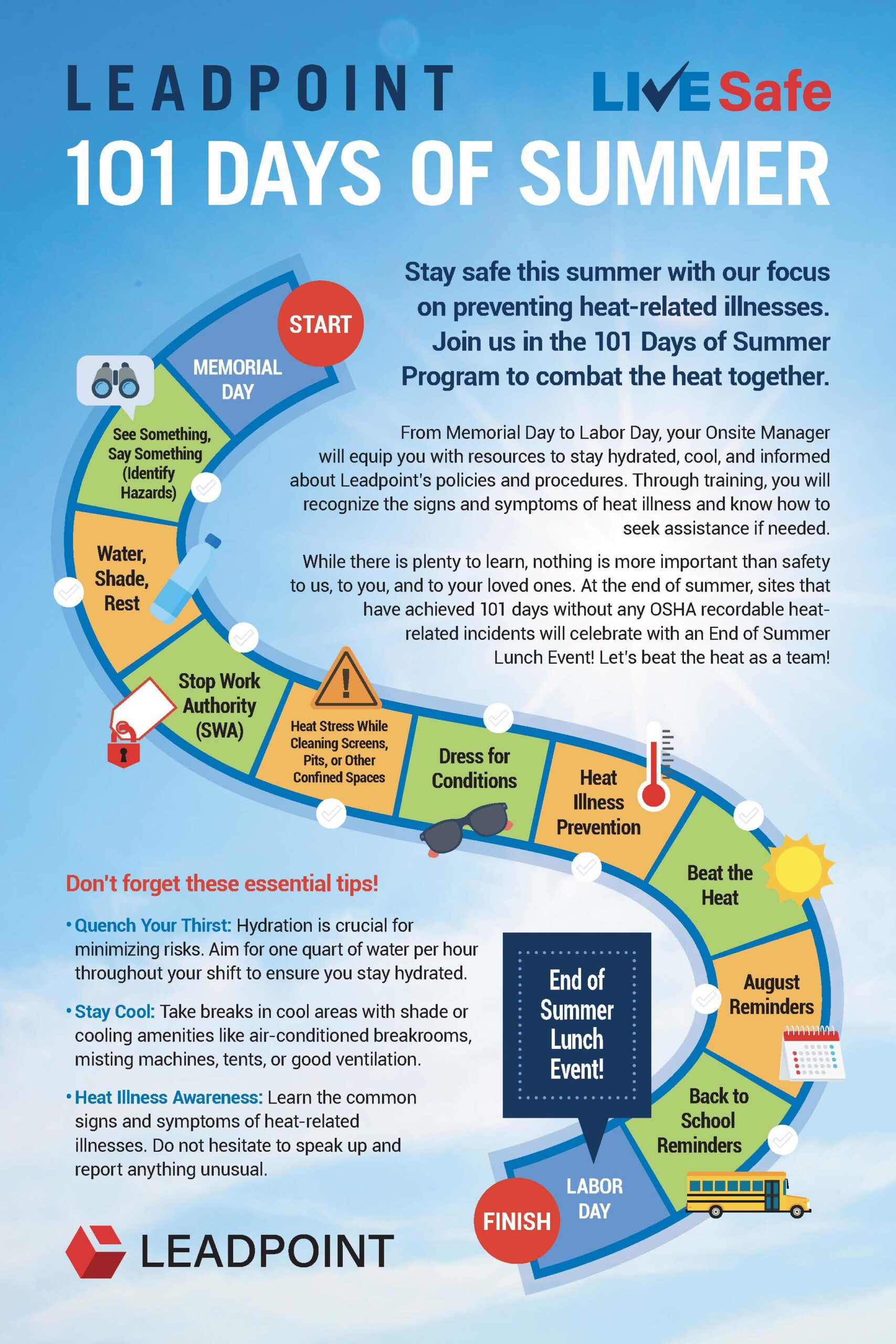Every summer, managers, supervisors, and employees inevitably face the question of how to prevent heat stress in the workplace. Leadpoint’s on-site managers offer some best practices for keeping employees safe as summer temperatures rise.
We asked, “How can I prepare for the hot weather and be ready when it gets here?”
- Create a plan to help alleviate heat stress issues at your facility. Communicate your plan with owners and managers and get their buy-in.
- Communicate with employees early and often. Get them thinking about their personal hydration plans—at work and at home.
- Make sure fans and misters are in good working order. Get them repaired or replaced before you need them.
- Order hydration drinks and additional water bottles ahead of time so you don’t run short while waiting for an order to come in.
- Watch the local weather report to know when those extremely hot days are coming.
What precautions can be taken to prevent heat stress-related injuries?
- Communicate with employees early and often. Yes, this is a repeat of the preparation tips! Every employee should understand the importance of staying hydrated before, during, and after work. Their health and heat safety are our concerns!
- Make heat stress a regular topic at safety meetings.
- Post bulletins about heat stress and how to identify and prevent it in high-traffic areas where employees can read it.
- Train line leads to recognize the symptoms of heat stress and how to differentiate it from the more dangerous symptoms of heat stroke. They should know the signs and what to do if an employee exhibits those symptoms.
- Monitor employees throughout the day to make sure they are drinking enough water and have it readily available.
- Allow for more frequent breaks for employees. Rotate one or two employees off the line at a time to the break room for short breaks so they can cool off. This is especially important on days with excessive high heat.
- Encourage employees to wear lighter, more breathable clothing in the summer months.
 The period between Memorial Day and Labor Day is crucial. Leadpoint has created a summer program focused on heat safety – 101 Days of Summer. Each site receives a road map on combatting heat and staying safe. At the end of summer, sites without any OSHA heat-related incidents will celebrate with an End of Summer Lunch Event. Some highlights of the program include:
The period between Memorial Day and Labor Day is crucial. Leadpoint has created a summer program focused on heat safety – 101 Days of Summer. Each site receives a road map on combatting heat and staying safe. At the end of summer, sites without any OSHA heat-related incidents will celebrate with an End of Summer Lunch Event. Some highlights of the program include:
- Road Map: Every site receives a 101 Days of Summer poster with a roadmap for dealing with heat and staying safe. The poster is placed prominently and kept up until Labor Day. (View Leadpoint’s 101 Days of Summer Road Map.)
- Resources: The Leadpoint Safety Team, client, and site collaborate to ensure every site has essential summer items to stay cool, hydrate, and provide rest/shade for their local weather conditions.
- Training: Specific heat-illness training is provided to managers.
In summary, it makes good safety sense to revisit the topic of heat-related injury every year. Continuous communication with on-site leadership and employees can help reduce incidents and make those hot summer months manageable.
About Leadpoint
Since 2000, Leadpoint has specialized in providing labor solutions, offering safe, productive, and stable work teams to the waste, environmental, and manufacturing industries. Leadpoint’s outsourced, supervised workforce model alleviates the challenges of recruiting, training, onboarding, and supervising employees, freeing up its customers’ time and resources. Its cost-effective solutions are designed to meet the evolving needs of the industries it serves. Recognizing the critical importance of a reliable workforce in achieving operational and profitability goals, Leadpoint is the single-source solution for recruiting and workforce services. Based in Phoenix, Leadpoint aims to streamline operations and enhance business performance nationwide. https://leadpointusa.com
Editor’s Note: This article has been updated to ensure it accurately represents the latest information from Leadpoint. While the original version was published in June 2018, we have made revisions to provide our readers with the most current insights from Leadpoint. Thank you for your continued support and interest in our content.

